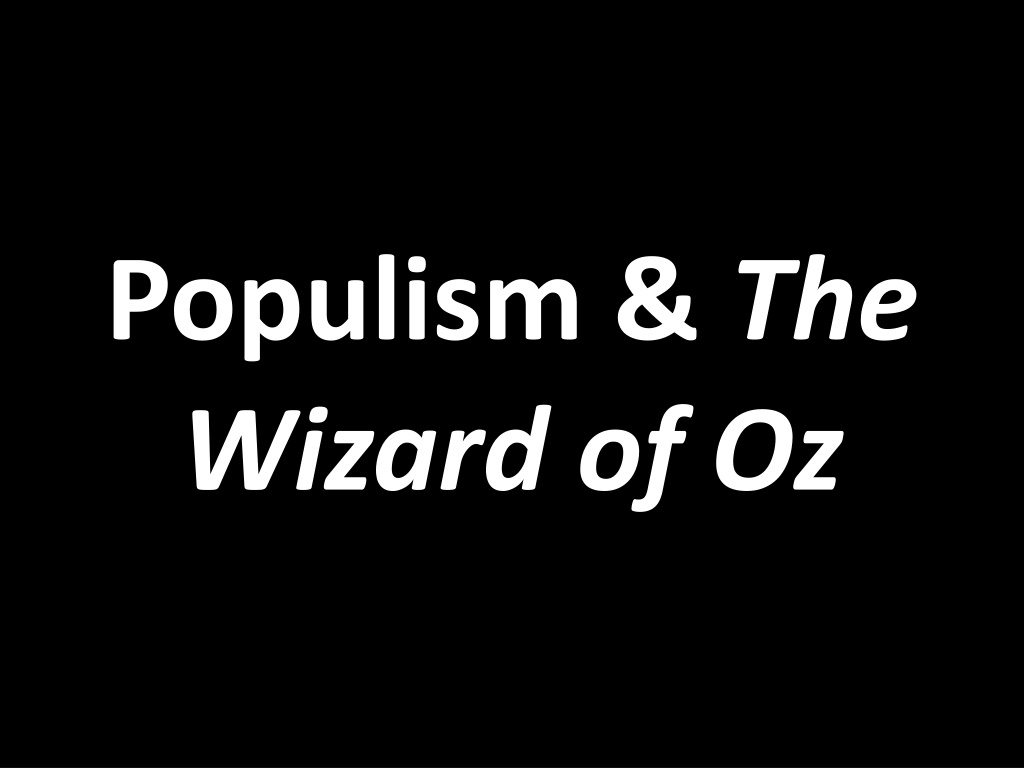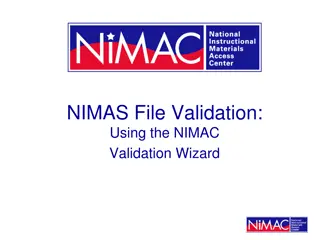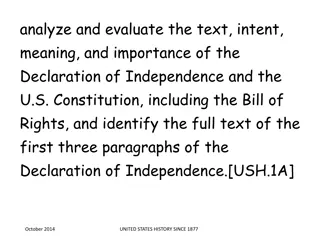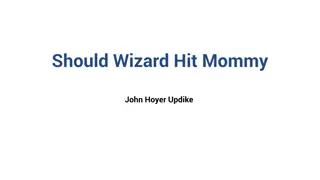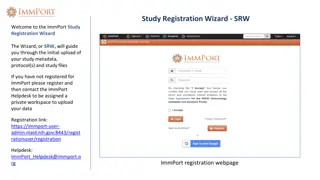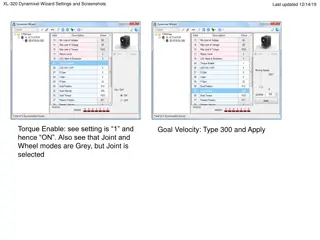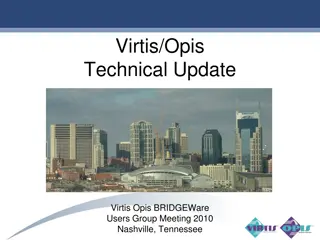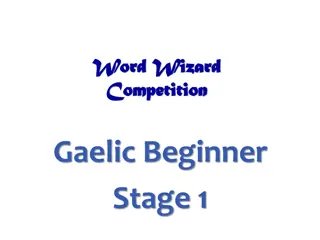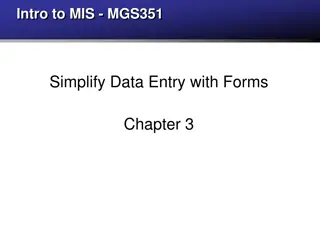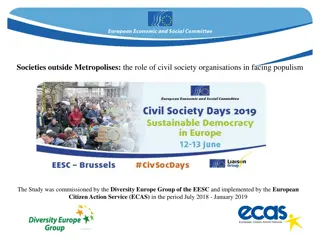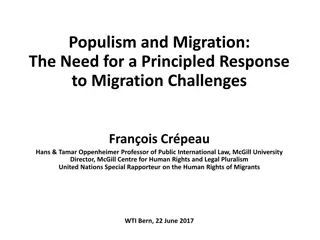Exploring Populism Through "The Wizard of Oz
In "The Wizard of Oz," various characters symbolize key elements of the Populist movement in American history. Dorothy embodies the determined average American, while Toto represents the temperance movement, and the Wicked Witch of the East signifies the Eastern bankers and industrialists. The Silver Slippers symbolize the Populist belief in silver currency, and the Munchkins represent the marginalized "little people" in society. Through these characters, the story mirrors the struggles and aspirations of the Populist Party during that era.
Download Presentation

Please find below an Image/Link to download the presentation.
The content on the website is provided AS IS for your information and personal use only. It may not be sold, licensed, or shared on other websites without obtaining consent from the author. Download presentation by click this link. If you encounter any issues during the download, it is possible that the publisher has removed the file from their server.
E N D
Presentation Transcript
Populism & The Wizard of Oz
Dorothy This character represents the level-headed, determined, and resourceful average American who, despite being caught in a "whirlwind" of differing opinions, and being led astray by the promises of corrupt politicians, overcomes all obstacles in their path; "home" is in Kansas, the stronghold of the Populist Party
Toto This character represents the temperance movement, a "pet" project of many Populists; temperance often caused the Populists to lose support from would be allies, such as urban Catholic factory workers, much like this character distracts Dorothy from attaining her objectives throughout the story by running off at inopportune times
The Wicked Witch of the East This character represents the bankers and industrialists of the East Coast; these are the interests who want to prevent silver from empowering the "little people" whom they keep under their control by keeping them impoverished and in debt; once this character is destroyed (ironically enough, by a farm house - the very thing that Eastern bankers were trying to take from Plains farmers) the "little people" are released from their bondage
The Silver Slippers This represents the Populist belief in the power of silver currency; the Wicked Witch of the East had kept silver under her strict control until Dorothy "liberates" it from her and combines it with gold (bimetallism) to take her where she needs to go - the Wicked Witch of the West is determined to prevent Dorothy from harnessing the power of silver - but eventually Dorothy uses the silver to achieve her ultimate objective (going home) just as the Populists hoped to use it to achieve their goal of relieving the economic distress of farmers
The Munchkins These characters represent the "little people" of American society, the average worker who, regardless of their profession, have their rights ignored by the corrupt politicians and the interests of "Big Business"; they will only achieve their "freedom" from the Wicked Witch of the East once the power of silver is unleashed
The Good Witches (North & South) This character represents the few business and political allies that the Populists found in the industrial centers of the North (primarily in Chicago); they can provide some valuable guidance, but lack sufficient power to provide any real assistance against the "wicked" influences of the East and West; her counterpart in the South is equally powerless due to the lingering effects of Reconstruction
The Yellow Brick Road This represents the Populist view that it was dangerous to base all US currency only on gold; relying on gold leads the story's characters into dangerous situations and ultimately to the corruption of the Emerald City, hence it is the path to ruin
The Scarecrow This character represents farmers, who were considered "brainless" by the general population but who are actually much more intelligent and tenacious than anyone gives them credit for; at the end of the book (but not the film) this character ends up ruling Oz, the way Populists hoped farmers would someday hold political power in the US
The Tin Man This character represents the "robotic" industrial workers who take a "heartless" attitude towards the struggles of the farmers despite the fact that Populists believed that factory workers and farmers made for natural allies against the interests of their common enemies of "Big Business" and pro-business/anti-labor federal government; he was made the way he is because of a curse put on him by the Wicked Witch of the East
The Cowardly Lion This character represents William Jennings Bryan, the Populist/Democratic presidential candidate who was an excellent speaker (had a loud "roar") but never any real political power (no "bite"); king of the "jungle" (in this case, the untamed wilderness of the Great Plains, where most Populists lived), but has no influence in the cities (Bryan was not popular with urban workers); many people also accused Bryan of being "cowardly" for his opposition to the Spanish American War
The Emerald City This represents the capital of the United States, Washington DC; this is where the gold standard will lead you - to corrupt politicians and empty promises; also, since it is "green", it represents the distrust the Populists feel for paper currency ("greenbacks")
The Wizard of Oz This character represents the Populists' disgust with the President of the United States and all other politicians who did their dirty-dealings "behind the curtain"; he tells all the other characters only what they want to hear, tricks them into actions which serve his interests and not their own, and fails to fulfill any of his promises; he eventually leaves Oz in balloon filled with "hot air."
The Wicked Witch of the West This character represents the harsh environmental conditions of the West, a constant enemy of the Midwestern farmer, she can only be overcome by water; closely allied with the other threat of the West, the Native Americans; also, because she is green she represents the dangers of paper money ("greenbacks"). She will do anything to keep Dorothy from controlling the power of her silver slippers.
The Flying Monkeys These characters represent the Plains Indians, a constant worry to the farmers of the west due to their wild and uncontrollable nature; one of the many dangerous allies of the Wicked Witch of the West. They were once peaceful and in tune with nature, but have become hostile and dangerous due to the corrupt influence of the Witch
The Land of Oz This represents America itself, but also "ounces" or the unit of measure for both gold and silver (remember, Populists supported bimetallism, or the minting of both gold and silver coinage) --- THINK ABOUT HOW YOU ABBREVIATE! Ounces = oz.
